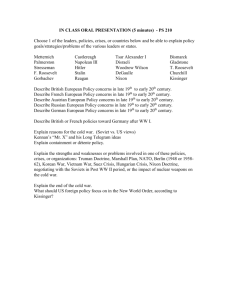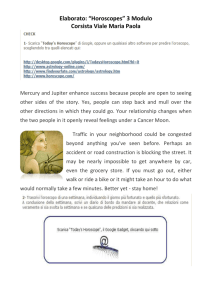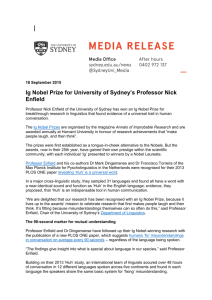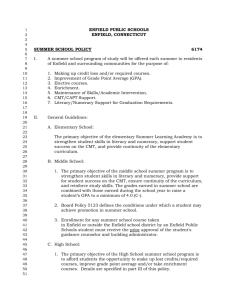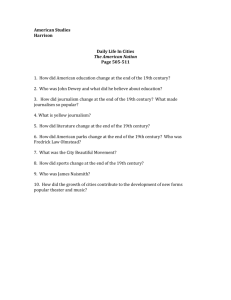June - Enfield Archaeological Society
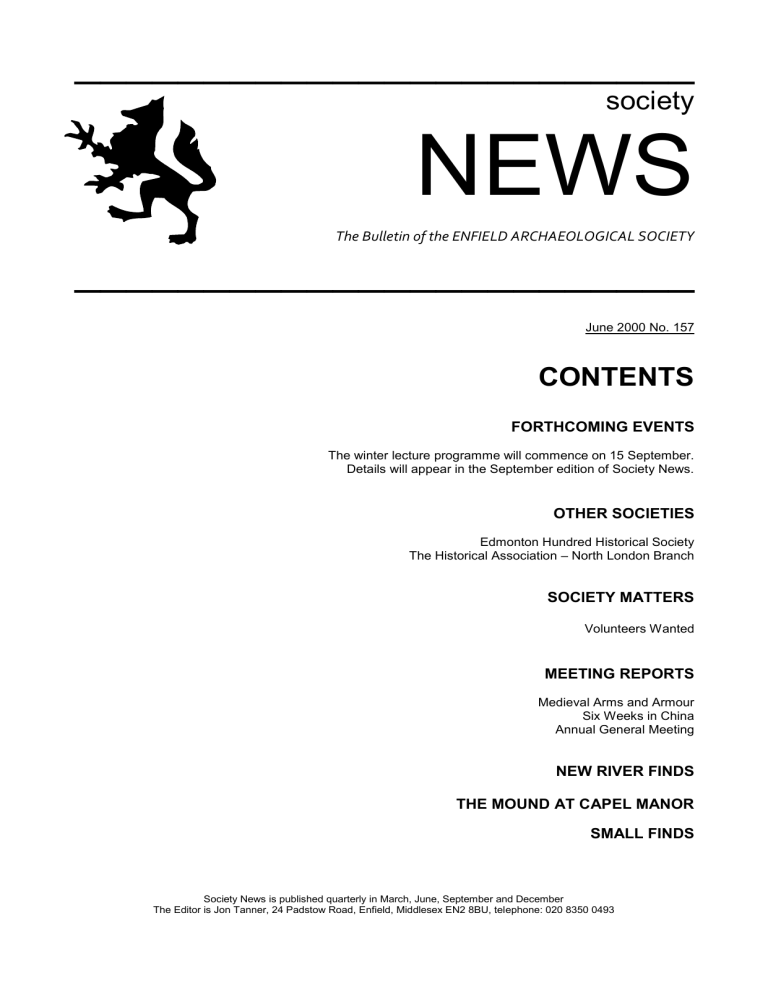
________________________ society
NEWS
The Bulletin of the ENFIELD ARCHAEOLOGICAL SOCIETY
________________________
June 2000 No. 157
CONTENTS
FORTHCOMING EVENTS
The winter lecture programme will commence on 15 September.
Details will appear in the September edition of Society News.
OTHER SOCIETIES
Edmonton Hundred Historical Society
The Historical Association – North London Branch
SOCIETY MATTERS
Volunteers Wanted
MEETING REPORTS
Medieval Arms and Armour
Six Weeks in China
Annual General Meeting
NEW RIVER FINDS
THE MOUND AT CAPEL MANOR
SMALL FINDS
Society News is published quarterly in March, June, September and December
The Editor is Jon Tanner, 24 Padstow Road, Enfield, Middlesex EN2 8BU, telephone: 020 8350 0493
FORTHCOMING SOCIETY
EVENTS MATTERS
Meetings of the Enfield Archaeological Society are held at Jubilee Hall, 2 Parsonage Lane,
Enfield (near Chase Side) at 8.00pm. Doors open at 7.30pm, tea and coffee is served and there is an opportunity to look at the sales and information table. Visitors, for whom a charge of
£1.00 will be made, are very welcome.
The Editor apologises for the late issue of this edition of Society News.
This has nothing to do with the attractions of Euro 2000, or even the first two Test Matches, as those of you who know me might suppose, but is due to a dissertation that had to be completed, followed by a fortnight’s excavation in South Wales.
Readers may console themselves with the
There is a break in the lecture programme for the summer, and we resume on 15 September with a lecture by Hedley Swain entitled
“Excavating Past Londoners – Archaeology on
Cemetery Sites”. Details will appear in the
September edition of Society News.
thought that there will not be long to wait for the
September edition!
FIELDWORK
It is proposed to carry out clearance work on a brickwork sluice on the New River at Myddelton
House in advance of surveying and recording.
Volunteers are asked to telephone Geoffrey
Gillam on 020 8367 0263.
MEETINGS OF OTHER SOCIETIES
Edmonton Hundred Historical Society
8.00 p.m. in Jubilee Hall, Parsonage Lane,
Enfield unless otherwise s tated. Visitors £1.00
20 June 2000
John Prosser
Bruce Castle Part 2 at Bruce Castle Museum
18 July 2000
Graham Handley
Thomas Hardy and the Enfield Connection
VOLUNTEERS STILL NEEDED
Volunteers are still required to help with the running of the Society. In particular, a new
Meetings Secretary to take over from Geoffrey
Gillam would be very welcome, as although
Geoffrey has arranged an excellent programme of speakers for 2001, he has expressed a desire to relinquish these particular duties after many years of service to the Society in a number of capacities.
We also need volunteers to help deliver
Society News – delivery rounds do not number more than about a dozen copies.
If anyone is able and willing to help in these - or in any other - ways, please contact the Chairman Dennis Hill, telephone 020 8440
Historical Association - North London Branch
All meetings are held at 8.00 p.m. in Jubilee
Hall, Parsonage Lane, Enfield.
For details, contact Robin Blades, 020 8368
5328
1593.
NEW LOOK FOR SOCIETY NEWS
Most readers will be aware that both
Archaeology and Current Archaeology
British
have
13 June 2000
Dr. Rohan McWilliam
Popular Radicalism in Mid-Victorian London recently been completely revised and updated in their formats and layouts. Not to be out-done,
Society News
The Editor sincerely hopes that it meets with approval, as it’s much harder work!
also has something of a new look.
2
MEETING REPORTS
Medieval Arms and Armour
Friday 18 February 2000: Mike Dewberry
Mike Dewberry is not only a member of the
Enfield Archaeological Society but is also a member of a touring group called the “The
Golden Eagles”, who give demonstrations of archery, sword play, jousting, falconry and other medieval pursuits – all portrayed as accurately as possible. Unusually, this lecture was not accompanied by slides, but instead the evening began with the distribution of handouts containing illustrations of medieval armour and weaponry, and the members and visitors present could clearly see an alarming assemblage of swords, daggers, bows and arrows and the like glinting on the table more accustomed to supporting the projection screen.
The speaker began by describing the longbow, showing an example made by Richard
Head, which requires a pulling strength of 55-60 lbs. Examples recovered from the Mary Rose however have pulling weights of between 150 and 180 lbs. and there is skeletal evidence from the medieval period of disproportionate development of one arm in archers.
The longbow was an extremely effective weapon used by the English – bowmen of the army of Edward 1 decimated the Scottish pikemen at the Battle of Falkirk, for example, and the use of the bow at Agincourt is well known. The English longbow, which may actually have its origins in Wales, was ideally made of English or Spanish yew, although ash and hazel were also used, with the sapwood on the outside of the curve and the heartwood in the inside to form a natural spring. Bows were
1675 – 1830mm (5½’ - 6’) long and were carried unstrung with the flax linen or hemp strings being carried in a leather pouch worn on the belt. Arrows were not, as is commonly supposed, carried in a quiver on the back but also slung from a belt. In action, arrows would be stuck in the ground to be instantly to hand and ready for use (the dirt on the tip thus adding an inadvertent element of biological warfare).
The fletching, or feathers, on arrows were from the duck or goose and adhered with bluebell sap before binding and ash was the preferred material for the shaft. The command orders were “nock, stretch, loose” and a skilled bowman could shoot 12 arrows per minute - at
Crecy in 1346 some 72000 arrows were shot at the French in 90 seconds. The French preferred the crossbow, which had a much lower rate of fire of 3 bolts per minute.
Bowmen would usually carry small arms and engage in close combat as light infantry when all their arrows were discharged or the course of the battle dictated, such weapons including the buckler (a small shield) and a dagger for thrusting through an armoured opponent’s visor or joints in the armour. A quilted jacket was frequently worn, often with a helmet.
The longbow was in common use until
1595, although the last use is believed to have been in World War 2 when Mad Jack Churchill used a longbow to kill a German infantryman.
The speaker then moved on to discuss armour, explaining that chain mail was worn by the Roman army, and prehistoric armour is also known. An example of chain mail made by the speaker was shown and the different types including riveted and split ring mail were described. Little is known of banded mail beyond the illustrations in the Bayeux tapestry, where Bishop Odo is shown in scale armour
(and wielding a cudgel). A mail halberd made by the speaker was shown, a long shirt like garment that weighed 3½ stone and contained
35000 links – but could be pierced by an arrow.
Another hazard was sweat causing rust, which in turn could lead to blood poisoning in the event of a wound. Quilted garments were worn under the chain mail. The use of mittens began in the 11 th –12 th centuries and the 14 th century saw the transition to plate armour.
The 9 th –12 th centuries was the age of knights. Originally armed horsemen – hence
“chevalier” – knights were a high status military elite and a suit of armour and weaponry was extremely expensive. The armour was also extremely hot – many knights died literally in the heat of battle - through heat exhaustion rather than enemy action. The lifting of a visor for a breath of fresh air however was likely to invite a
“sniper’s” arrow. Contrary to the modern image of chivalry, these conflicts were brutal and bloody affairs, with numerous acts of butchery that would be considered a war crime today – non-knights, if captured, would be summarily despatched as no ransom could be obtained.
3
Moving on to other weapons, Mr
Dewberry produced an enormous single-handed broadsword, which was passed around for its weight to be experienced. An even larger double-handed sword was also shown. The preferred weapon however was the poleaxe, which could be used as either a stabbing or a slashing weapon.
The age of the knights was brought to a close by gunpowder and the use of firearms, and fittingly the lecture was concluded with the presentation of musket balls to everyone as a memento of the occasion.
This was a thoroughly enjoyable and lively lecture, liberally sprinkled with quips and anecdotes, which both informed and entertained.
Jon Tanner
Six Weeks in China
Friday 17 March 2000: Carmen Keller Lange
Once again, the Society was able to draw upon its own membership for a speaker at a monthly lecture meeting, when Carmen Keller Lange described her study tour of China undertaken as part of her MA in Chinese Archaeology.
China is a particularly exciting area for archaeology as so much remains to be discovered. The model army of 7000 terracotta soldiers from near Xi’an in the Shaanxi province is now well known, but less well known is that no two of the soldiers faces are alike: indeed all the racial groups of China appear to be depicted. A range of ranks of officers, infantrymen and cavalrymen are included together with over 600 clay horses and in excess of 100 war chariots. The ceramic combatants were apparently intended to guard the Emperor Qin Shihuangdi after his death in
210BC.
Ms Keller Lange described in detail the
65 bronze bells from the Leigudun tomb in the province of Hubei. The bells date from the 5 th century BC and bear inscriptions giving details of melodies and scales of the period. A recording of the bell’s music was played, which is surely something of a first for the Society.
Slides were shown of many tombs, palaces and other buildings including of course the Great Wall, which arrived at its present form
4 by the connection of a series of earlier walls.
Ms Keller Lange concluded her intriguing talk with several amusing anecdotes from her oriental adventure, that demonstrated the great kindness shown to a stranger by the many
Chinese people with whom Ms Keller Lange came into contact.
Mick Breheny
Jon Tanner
Annual General Meeting
Friday 14 April 2000
The 44 th Annual General Meeting of the Enfield
Archaeological Society was opened by the
Chairman, Dennis Hill, who extended a warm welcome to all present. Apologies for absence were received from Mrs Perez, and the Minutes of the 43 rd AGM held on 16 April 1999, having previously been distributed in Society News
153, were agreed as being a true and correct record of the meeting and were signed by the
Chairman.
The Report of the Executive Committee had been distributed with the March edition of
Society News (no. 156) and was accepted by those present.
The Financial Statement for 1999 was distributed at the meeting, and Treasurer Ian
Jones rose to expand upon the report. The accounts show a small deficit over the year. An increase in subscription rates from January
2001 is proposed, due to the increased costs of printing and distributing Society News, the mounting of exhibitions and the carrying out of excavations. Mr Jones noted that this is the first increase in subscription rates for several years.
The sum of £11.99 expended at the Forty Hall
Pavilions Excavation was queried from the floor: the Treasurer explained that this expenditure covered the cost of a broken bow saw, defeated by the gallant resistance of a large tree root.
Approval of the accounts was proposed by
Geoffrey Gillam, seconded by Leonard
Hemming and duly approved by those present.
The Chairman expressed the thanks of the
Society to the Auditors and to Ian Jones.
The next item, no. 4, on the Agenda related to amendments to the Constitution as proposed by the Executive Committee, as follows:
4) MEMBERSHIP
Delete existing item 4b):
The membership subscription, payable in advance, shall be £4.00 per annum and for those members under 18 years of age, £2.00 per annum. The Executive Committee will give special consideration to applications from students. Membership subscriptions shall become due on 1st January each year .
Delete existing item 4c):
Two or more members living at the same address may pay a joint or family rate of subscription of £6.00 per annum.
Insert new item 4b) as follows:
The membership subscription, payable in advance, shall be at a rate or rates to be proposed by the Executive Committee for acceptance at the Annual General meeting. The
Executive Committee will give special consideration to applications from students.
Membership subscriptions shall become due on
1st January each year .
Existing item 4d to be renumbered item 4c and existing item 4e to be renumbered item 4d
These amendments were considered necessary in order to avoid the need to amend the
Constitution whenever the subscription rate is revised, and were accepted by those present.
Item 5 on the Agenda was “Subscriptions”. The
Executive Committee proposed the following subscription rates for the year 2001:
Ordinary Members: £5.00
Junior Members
(under 18 years of age): £2.50
Joint Membership: £7.00
The Chairman then moved on to item 6, the
Election of Honorary Officers and Committee
Members. The existing Executive Committee stood for re-election, with the notable exception of John Stevens. After many years service to the Society as Secretary and Editor of Society
News , and more recently as Acting Membership
Secretary, John has stood down as he will be leaving the Enfield area to live in Kent. On behalf of the Society, the Chairman expressed thanks for all John’s work, and wished him well in the future.
5
The Executive Committee was then re-elected unopposed, as follows:
President: Harvey Sheldon
BSc FSA FRSA
Vice Presidents: Dr Ilid Anthony
Ivy Drayton
Dr John Kent
Geoffrey Gillam
Chairman: Prof. Dennis Hill
Ian Jones Vice Chairman:
Treasurer:
Gen. Secretary:
Meetings Secretary:
Ian Jones
Jon Tanner
Geoffrey Gillam*
Membership Secretary: Jon Tanner*
Editor: Jon Tanner
Michael Ranson Auditor:
Committee: Roger Dormer
Roger Eddington
Les Whitmore
Caroline McKenna
Peter Warby
(co-opted 1999)
* denotes “Acting” capacity.
There were no nominations for the position of
Social Secretary.
Dennis Hill appealed for a volunteer to step forward for the position of Meetings Secretary, as Geoffrey Gillam wished to reduce his workload. Dennis was pleased to note that a member has offered to help Caroline McKenna with the Sales and Information Table, and Mick
Breheny has taken on the task of submitting reports of meetings to the local press.
The only item under “Any Other
Business” was the announcement that Geoffrey
Gillam is to receive the Ralph Merrifield Award for his services to archaeology at the annual
LAMAS Conference of London Archaeologists.
Geoffrey then rose to give a report on the
Society’s activities, excavations and research during 1999, and began by showing a slide of an artefact found in a garden near Hillyfields
Park ( Society News 155) Although initially identified as a Roman ear scoop, the object has
since been examined by John Clark of the
Museum of London, who believes it to be part of an 18 th century toiletry set.
Some of the original fireplaces at Millfield
House had been stolen and it had been feared that no record remained. However, George
Legroux of Enfield Arts Council had taken photographs of one of the fireplaces, and kindly sent copies to Geoffrey Gillam.
Geoffrey went on to describe a part of
Maide n’s Brook in Forty Hall where a sandy bank has been suffering degradation, and creating a threat to adjacent remains of Elsyng
Palace ( Society News 155). The bank is also a nesting habitat for kingfishers, and was inspected by representatives of the Society, the
Enfield Preservation Society, English Heritage, and L B Enfield. It was concluded that the bank should be reinforced with a system resembling wire baskets.
Research has been carried out into the history of film and TV commercials in the
Borough ( Society News 154 and 155). A fictitious shopfront in Forty Hall called “Posh
Pets” was constructed solely for the filming of an advertisement, and the facade remains – the actual shop was the premises of a confectioner and tobacconist trading as “the Bonbon”.
The commercial field unit Pre-Construct
Archaeology have carried out excavations at
Plevna Road and Monmouth Road in Edmonton as part of the PPG16 process. Many flint artefacts have been recovered, among which was a splendid handaxe, and there is much evidence of Bronze Age activity, including field systems.
The Enfield loop of the New River is being re-modelled by L B Enfield with the aid of lottery funding. The channel is to be lined with butyl sheeting and the banks are being re-lined with timber revetments; railings and lamp standards are to be replaced with new items of varying historical accuracy. As part of a desilting exercise, a large lagoon was formed in the
Town Park with the intention of drying out the dredged silt. Two Society members, Mike
Dewberry and Dave White, explored the lagoon with metal detectors and a number of objects were retrieved. Ian Jones has examined the finds and his report appears elsewhere in this edition.
Forty Hall is now closed during the week, and is open for very limited periods at weekends. The Trust set up to manage the house and preserve public access is endeavouring to progress the agreement with
LBE, but it appears to be a daunting task for
LBE to produce accurate figures.
6
Research into the ornamental gardens of Forty
Hall continues, under the direction of Geoffrey
Gillam. The lane from the Home Farm is possibly associated with the southern boundary of the Elsyng deer park. Among the features shown on a 1773 Sale Plan are three garden gazeboes, or pavilions. One has not yet been found, but two were located and excavated by the Society in 1999. A detailed report appeared in Society News 155 and 156. The West pavilion, of which only the base and a scatter of tiles remain, was probably a timber structure and has been dated by two bricks stamped
“BHP” – the Bush Hill Park brickworks were open between 1875 and 1906. The base is badly cracked but mortar from joints in a brick floor remains, as do slots that once housed benches. The pavilion was built on the crest of a raised walk, part of the ferme ornee constructed in the 18 th century.
The East pavilion dates from about 1740 and was a more substantial brick structure with a tiled roof. It is possible that some of the bricks were re-used from Elsyng Palace, and the structure stood until it was demolished in 1951 by L B Enfield. A piece of collapsed masonry allows the pitch of the roof to be deduced, and some plaster remains. The north and south walls are both out of plumb, leaning to the south
- the southern wall considerably so.
The original floor level can be determined by the position of slots in the masonry for the fixing of skirting and dado rails: holes for floor joists also remain. Both peg tiles and slates were found, together with a piece of fire grate and remains of green linoleum. Other finds include a quantity of animal bone suggesting the remains of picnic hampers, a 19 th century clay pipe and a spirits (probably vodka) bottle dating from 1870-1910. Gunflints and shotgun cartridge bases point to the use of the pavilion by shooting parties.
Elsewhere in the grounds is a piece of concrete with protruding cast-in steel angles: this is a Second World War anti-glider device, which Geoffrey Gillam suggests may have originated in the straight portion of the A10.
The Society is grateful to Steven
Dowbiggin, Principal of Capel Manor College,
Rob Prideaux, farm manager, and Dave Howlett of Forty Hall, for all their help and assistance during the research and excavations at Forty
Hall. The book “Forty Hall Enfield” by Geoffrey
Gillam and published by the Society is still available at local bookshops.
Dennis Hill then drew the 44 th Annual
General Meeting to a close.
Jon Tanner
Finds From the Cleaning of the New River in 1998/9
As a result of the recent cleaning out of the New
River in Enfield a vast amount of mud was dumped in the Town Park to dry. Only a small part of the immense mass of material could be investigated because it dried out only slowly mainly because the water was not allowed to soak away into the ground. Over several months two members of the Society, Michael
Dewberry and David White, to whom the
Society would like to offer its thanks, examined the fringes of this heap with metal detectors.
They recovered and in part identified a wide range of coins, pottery and other artefacts, which showed that from the moment the channel was dug in the early years of the 17 th century various items of rubbish and possible good luck offerings found their way into it. The coins discovered range in date from a shilling of
Charles I, 1625 - 1649, to a 1959 shilling of
Elizabeth II. Some of the pottery found predates the digging of the channel and presumably found its way in while work was underway. Despite the smallness of the area investigated the finds represent a good selection of the sorts of things that will turn up on sites dating from the last four centuries in
Enfield. Because the items lack a precise context and, the design of many of them has changed little over the centuries - for example the thimbles - exact dates often cannot be given. The objects listed below are arranged by type and in chronological order as far as possible.
COINS, BRITISH.
01. Three unidentified coins.
02. Shilling, Charles I, 1625-1649.
Struck at the Tower Mint under the authority of Parliament in either 1645-6 or
1646-8. The exact date cannot be given, as the mintmark cannot be made out.
03. Shilling, William III, 1694-1702.
A type 1 shilling issued 1696-7 and minted at Exeter. On the reverse separate shields bore the arms of
England, Scotland, Ireland and France with the lion of Nassau in the centre.
04. Halfpenny, 20th century.
05. Halfpennies, Queen Victoria, 1883,
1888,1890, 1901, 1901.
06. Penny, Queen Victoria, 1899.
07. Farthing, Edward VI, 1907.
08. Halfpenny, Edward VII, 1906.
09. Pennies, Edward VII, 1909, 1910.
10. Halfpennies, George V, 1914, 1914,
1919, 1920's, 1920's, 1925.
11. Pennies, George V, 1912, 1913, 1915,
1917, 1919, 1921, 1935.
In general the condition of the pennies of
George V was much better than that of all the other base metal coins except the most recent.
12. Sixpences, George V, 1920, 1929, 1929.
13. Halfpennies, George VI, 1938, 1944,
1952.
14. Pennies, George VI, 1938, 1939.
15. Threepence Piece, George VI, 1942.
16. Shilling, George VI, 1944.
17. Florin, George VI, 1948.
18. Threepence Piece, Elizabeth II, 1954.
19. Sixpences, Elizabeth II, 1953, 1957.
20. Shilling, Elizabeth II, 1959.
COINS, FOREIGN.
21. France. Five Centimes Piece, Napoleon
III, 1862.
22. Germany. 1 Pfennig, 1892.
23. India. 1 1/12th of an Anna, 1893.
24. Token. Possible 18th or 19th century trade token.
7
OTHER OBJECTS.
25. Badge. Regimental Badge, Royal
Engineers, George V pattern, 1911-1936.
26. Brooch Made from two silver
Threepenny Pieces of Queen Victoria dated 1887 and 1890.
27. Buckle. Bronze, 17th century.
Building Materials.
28. Possible Roman red tessera.
29. Fragment of tile, date uncertain.
30. Two peg tile fragments with peg holes.
17th century.
31. Cream glazed tile fragment, 18th/19th century.
32. Pegtile fragment, 18th-20th century.
----------------------------------------------------------------
33. Button. Conical with flower on apex. 17th century.
34. Button. Plain conical button. 17th century.
35. Buttons. Royal Navy and probably Livery, late 19th-early 20th centuries.
36. Buttons. Five flat plain metal blazer type buttons. 20th century.
37. Buttons. Two flat convex buttons. 20th century.
38. Button. Convex dress button with spiral pattern. 20th century.
39. Ear Scoop. Silver ear scoop of 18th or
19th century date from a necessaire or vanity set which would also have included scissors, tweezers and a folding knife amongst other toilet items.
40. Footware. Iron base of a paten. This originally supported a wooden sole a short distance off the ground and when strapped to ordinary shoes would keep them out of the wet and mud. 18th or 19th century.
8
41. Flask Top. Brass top probably from a glass flask. 19th/20th century.
42. Frame. Pieces of a copper alloy frame from either a picture or a small mirror.
The outer edge is decorated with crude cherubs. 19th century.
43. Handle. Brass, from a small cabinet or drawer. 19th century.
44. Handle. Brass sheet, possibly from a handle. Date uncertain.
45. Harness. Copper alloy harness mount.
The central boss is decorated with a crude head probably meant to be a
Roman emperor. 19th century.
46. Identity Disc. Guide Dogs for the Blind
Association. Issued to Miss H. Wright of an as yet unidentified Enfield address.
Late 20th century.
47. Key. Part of a watch key with engraved decoration. 18th/19th century.
48. Keys. Two, Yale type, One numbered 7C the other stamped RST 1A Essex Shoe
Repairs. 20th century.
49. Musket Balls. Nine ranging from 10mm to
15mm in diameter. Two are cast and one of these has not been trimmed.
Tobacco Pipes
50. Pipe bowl 1770-1820 type. Initials PH on spur. Possibly Peter Hall working in Ripon in 1822. Information on pipemaker's names is constantly being added to and I have not yet been able to examine all the relevant printed listings.
51. Incomplete pipe bowl of Irish type 1850-
1910. Initials I (damaged) S on spur. One of the commonest sets of initials on pipes.
For this particular period we have the choice of Joseph. Slough, J. Southorn,
John Simpson, John Smith and J.
Shoesmith and others. To further add to the problem of identifying makers, some
London ones had the habit of using other craftsmen's moulds without bothering to change the initials.
52. Incomplete pipe bowl of Dutch type 1850-
1910 with stars on the spur.
53. Bowl fragment possibly of 1700-1770 type.
54. Fluted stem of a late 19th century briar pipe imitation type.
---------------------------------------------------------------
55. Plug. Brass sink plug, 19th/20th century.
56. Ring. Copper alloy with empty bezel,
19th century.
57. Ring. Gilded copper alloy, later 20th century judging from condition.
58. Thimbles.Two brass, late 19th/early 20th century.
58. Tooth. Sheep.
60. Toy. Soft metal fragment of a grille or window. Date uncertain.
61. Unidentified. Brass object with spiral handle. Date uncertain.
62. Weight. Lead. Date uncertain.
63. Weight. Lead discs, Date uncertain.
64. Weight. Lead line weight, 20th century.
POTTERY.
No complete vessels were found. All the individual sherds described as rim, body or base as appropriate. The lack of any archaeological context for these finds makes the precise dating, especially of the commonplace brown glazed wares, impossible.
65. Small body sherd of possible Roman greyware.
66. Grey and Buff body sherds, possibly
Medieval.
67. Base and flat rim sherd of green glazed
Surrey Ware. Both possibly from a chamber pot. 16th century/early 17th century.
9
68. Rim of Metropolitan Slipware from the
Harlow kilns. Yellow slip design over brown glaze on red fabric. First half of the 17th century.
69. Base of a bowl with internal yellow glaze.
17th century.
70. Body sherd from blackware flagon. 17th century.
71. Rim sherd from saltglazed Westerwald stoneware imported from Germany. Dark blue and grey glaze, grey fabric. 17th century.
72. Base of a Ferchen stoneware or
Bellarmine ware flagon imported from
Germany. 17 th century.
73. Unglazed rim, base and body sherds.
17th/18th century.
74. Five brown glazed rim sherds. 17th/18th century.
75. Seven brown glazed body sherds.
17th/18th century.
76. Three brown glazed base sherds.
17th/18th century.
77. Buff body sherd of brown combed creamware. Staffordshire or Bristol,
17th/18 th century.
78. Redware body sherd with buff and brown glaze. 19th century.
79. Base of a later 19th century Midlands made stoneware mug, brown glaze on grey.
80. Body sherd with part of handle of a large cooking pot. Cream glaze inside, brown glaze outside. 19th century.
81. Body sherd in white earthenware with transfer printed blue on white glazed landscape scene with trees and a human figure. 19th/20th century.
82. Body sherd from a large glazed vessel.
Dark brown glaze one side, transfer printed blue/grey vase of flowers on white ground on the other. 19th/20th century.
83. Rim of an earthenware Sainsbury's
Bloater Paste pot. Early 20th century.
Although this exercise produced nothing unexpected it has added several interesting items to our collections. This sort of recovery operation also demonstrates one area in which the metal detector is of great value archaeologically through its ability to aid in the recovery of material from places and in circumstances where it would be a waste of time and resources to employ normal archaeological methods. The material will eventually be lodged with the rest of the
Society's collections, hopefully in Forty Hall.
Ian K. Jones
Mound at Capel Manor
Inside the entrance to Capel Manor, just beyond the lodge, stands a simple earth mound about 9 metres in diameter and 2.5 metres high. Various theories put forward for its origin include that it conceals an ice house or that it was a garden mount upon which stood a pavilion or summer house. In an attempt to resolve the issue, the
Society arranged for a section to cut by machine. Dennis Hill, Geoffrey Gillam and Mike
Dewberry inspected the trench, which was cut from the centre to the outside edge of the mound, and report that the mound is composed of light loamy soil and brickearth: there was no stratification or archaeological dating evidence visible.
The mound is not the covering of an ice house and its relationship to the house and other garden features does not support the theory that it was a mount for a gazebo.
Conifers and holly trees have been deliberately planted on the mound but nowhere else in the vicinity. It is likely that the mound was part of the landscaping of the grounds, intended to screen the gate and adjacent lodge from the direct view of the present or earlier house. There is an abandoned and heavily overgrown sunken garden and a relatively modern, but derelict, summer house nearby but it is not clear if they are contemporary.
No further work on the mound is planned, although a detailed survey of the grounds of
Capel Manor using metal detectors is being arranged. We are grateful to Dr Dowbiggin
(Principal of Capel Manor) for inviting us to examine the site, and to the Estate Manager
Nick Evans for his assistance.
SMALL FINDS
SALISBURY HOUSE OPEN DAY
An open day at Salisbury House was organised by the Enfield Arts Partnership on Sunday 29
April, and various societies set up their stalls in the house and garden. Ian Jones, Roger
Eddington and Geoffrey Gillam arranged for a
15-minute pre-recorded talk on The History and
Archaeology of Salisbury House to be given throughout the afternoon. The talk was illustrated with slides, and there was also a display of photographs and drawings showing the excavations that the Society carried out in the grounds in 1998. Another Open Day is planned for 23 September.
ELSYNG PALACE SURVEY
A topographical survey of the area of Elsyng
Palace has been carried out MOLAS, using digital terrain modelling technology. The work was funded by L B Enfield, and is it hoped that a non-intrusive survey of the remains will be carried out including the use of groundpenetrating radar. However, the Society is gravely concerned about the neglect of this
Scheduled Monument the condition of which is deteriorating alarmingly, particularly as a result of tree root damage.
GALLERIES AS PUBS
Matthew Evans, the new chairman of the
Museums, Libraries and Archives Commission, does not appear to have endeared himself to professionals in the field. After accusing museums of a lack of concern for “social inclusiveness” and urging then to put “audience research before curators, access before preservation and people before collections – to reinvent themselves”, he asked “If visiting a pub is our favourite pastime, why not recognise that by exhibiting our collections in one?” The
Editor can refer Mr Evans to some Enfield pubs that already boast a collection of ancient relics.
HISTORIC HOWLER
From the bottomless pit of our collection of howlers:
Pharoah forced Hebrew slaves to make bread without straw. Afterwards, Moses went up to Mt.
Cyanide to get the Ten Commandments.... He died before he ever reached Canada.
10
